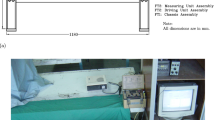Abstract
This paper extends the theta prediction methodology so that life predictions for materials operating under long service conditions can be made that also have a degree of confidence associated with them. Ways in which this model can be applied to the fatigue as well as the creep of all materials is also discussed. For comparison purposes two failure criteria are built into the stochastic model and the determinants of failure derived. This stochastic theta model is then used to investigate the nature of the creep failure time distribution for the Ti 6.2.4.6 alloy under constant uniaxial conditions. The distributions for each θ j were found to be very different—with only some of them being normally distributed. The others had very pronounced skews to both the left and right. The empirical distributions for predicted failure times were also found to have long tails reaching out to higher failure times—although the failure time distributions were more symmetric when using the Monkman—Grant failure criteria. For Titanium 6.2.4.6 operating at 773 K and 580 MPa the chances of failure before 410 hours is 1%. At 480 MPa and 773 K the chances of failure before 780 hours is 1%.
Similar content being viewed by others
References
R. W. Evans, I. Beden and B. Wilshire, in 2nd International Conference on ‘Creep and Fracture of Engineering Materials and Structures,' edited by B. Wilshire and D. R. J. Owen, Swansea, 1984 (Pineridge Press, Swansea, 1984) p. 1277.
R. W. Evans, M. R. Willis, B. Wilshire, S. Holdsworth, B. Senior, A. Fleming, M. Spindler, and J. A. Williams, in Proceedings of the 5th International Conference on ‘Creep and Fracture of Materials and Structures,’ Swansea 1993, edited by B. Wilshire and R. W. Evans (The Institute of Materials, London, 1993) p. 633.
R. W. Evans, Materials Science and Technology 16 (2000) 6.
P. H. Morton, Rosenhain Centenary Conference, The Royal Society (1975).
A. Greasley, Materials Science and Technology 13 (1997) 31.
R. W. Bailey, in Proc.I.Mech.E. 131 (1935).
F. Garofalo, in “Fundamentals of Creep and Creep Rupture in Metals” (Macmillan, New York, 1965).
R. W. Evans, Materials Science and Technology 5 (1989) 699.
R. W. Evans and P. J. Scharning, Materials Science and Technology 17 (2001) 487.
M. Evans, Journal of Strain Analysis 35(5) (2000) 389.
Idem., Journal of Materials Science 35 (2000) 2937.
W. H. Greene, in “Econometric Analysis” (Prentice Hall, New Jersey, 2000) p. 127.
R. L. Prentice, Biometrika 61 (1974) 539.
M. Evans, Materials Science and Technology 12 (1996) 149.
J. F. Lawless, in “Statistical Models and Methods for Lifetime Data” (John Wiley & Sons, New York, 1982) Appendix B.
F. C. Monkman and N. J. Grant, Proc. ASTM 56 (1956) 593.
Palisade Corporation, “@Risk: Advanced Risk Analysis for Spreadsheets” (Palisade Corporation, New York, 2000).
J. J. Thomas, in “An Introduction to Statistical Analysis for Economists” (Weidenfeld and Nicolson, London, 1983) p. 190.
M. R. Bache and W. J. Evans, International Journal of Fatigue 14(5) (2000) 331.
P. C. Paris and F. Erdogan, J.Bas Eng., ASME series D 85 (1963) 528.
R. W. Evans and B. Wilshire, in “Introduction to Creep” (Institute of Materials, Bournemouth, 1993) p.11.
M. Evans and A.R. Ward, Materials Science and Technology 16 (2000) 1149.
Author information
Authors and Affiliations
Rights and permissions
About this article
Cite this article
Evans, M. A stochastic lifing method for materials operating under long service conditions: with application to the creep life of a commercial titanium alloy. Journal of Materials Science 36, 4927–4941 (2001). https://doi.org/10.1023/A:1011844505952
Issue Date:
DOI: https://doi.org/10.1023/A:1011844505952




